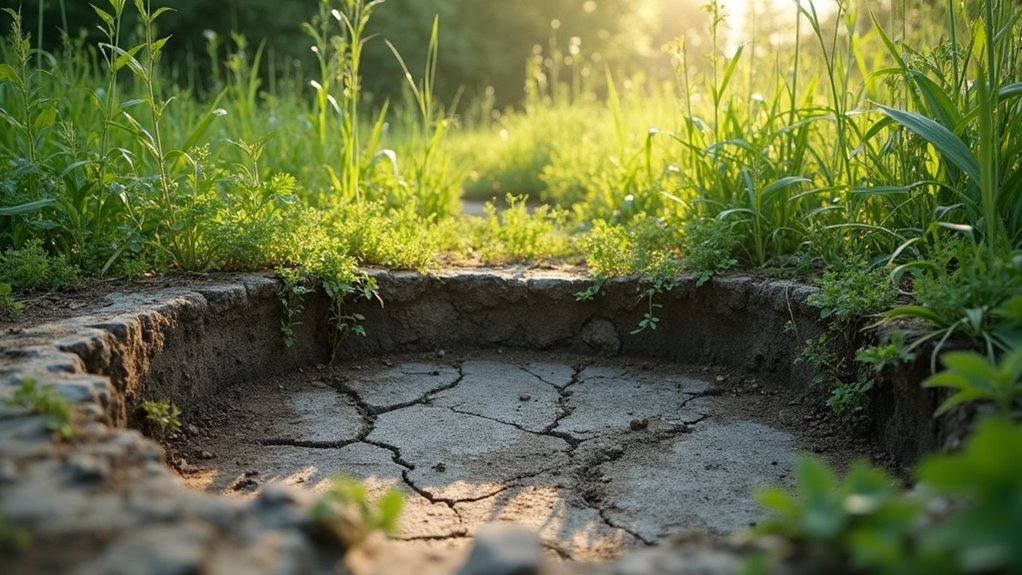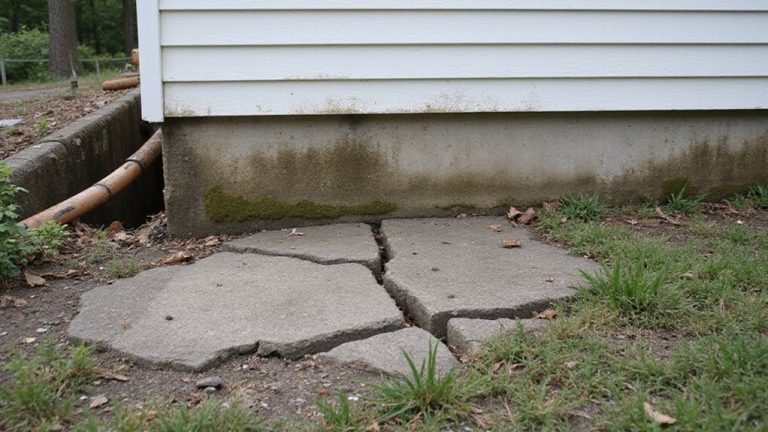As a homeowner, you know a sinking foundation can be a serious issue. But don’t worry – it can often be fixed. The key is understanding the root cause and choosing the right repair method. Whether it’s concrete leveling, mudjacking, or more extensive reinforcement, there are solutions to stabilize your home’s foundation and prevent further damage. With the right approach, you can restore your property’s structural integrity and protect your investment. Let’s investigate your options and find the best way to address your sinking foundation.
Causes of a Sinking Foundation
There are a few common causes of a sinking foundation. The soil composition around your home is vital – if it’s made up of clay or loose, sandy soil, it’s more prone to shifting and compaction, leading to foundation issues.
Water drainage problems can also contribute to a sinking foundation. If water isn’t properly channeled away from your home, it can saturate the soil and cause it to expand and contract, destabilizing the foundation. Foundation settlement issues can be particularly severe in northeast Ohio due to the region’s specific soil and climate conditions. Identifying and addressing these underlying causes is essential to fixing a sinking foundation before it becomes a bigger problem.
Signs of a Sinking Foundation
If your home’s foundation is sinking, you’ll likely notice several telltale signs. Look for cracks in walls, uneven floors, or windows and doors that won’t close properly. These indicate the foundation has shifted or settled unevenly.
Soil erosion and water damage around your home’s perimeter can also contribute to foundation issues. Observe the exterior for signs of crumbling or cracked concrete, as well as gaps between the foundation and the home’s siding. By catching these red flags early, you can address the problem before it worsens and becomes more costly to repair. Foundation contractors can help identify and stabilize bowing walls and other structural problems caused by soil pressure and settling.
Foundation Repair Options
Several options exist to fix a sinking foundation.
- Concrete leveling involves injecting a specialized concrete-like material under the sunken areas to raise and stabilize the foundation. This method is less invasive and often more cost-effective than traditional foundation repair.
- Mudjacking, an alternative to concrete leveling, uses a cement-based grout pumped beneath the foundation to lift and level it. This technique can be a viable option for homeowners seeking a budget-friendly fix.
- Strengthening, a more extensive repair, reinforces the foundation by drilling additional support piers or beams beneath it. This thorough approach may be necessary for severe foundation issues.
Underpinning: Lifting the Foundation
While the concrete leveling and mudjacking techniques can be effective in some cases, buttressing offers a more extensive solution for extensively sinking foundations. This process involves excavating beneath the existing foundation and installing new, deeper supports, like concrete piers or steel piles, to lift and stabilize the structure.
Buttressing provides a long-term, permanent fix for foundation problems, restoring the home’s structural integrity and preventing further sinking or damage. It’s a more complex and costly procedure, but it’s often necessary for severe foundation issues that require foundation stabilization and concrete lifting.
Slabjacking: Stabilizing the Slab
Oftentimes, sinking concrete slabs can be effectively stabilized through a process known as slabjacking. This technique involves pumping a specialized grout mixture beneath the slab to lift and level it.
The key benefits of slabjacking include:
- Concrete Lifting: The grout is injected through small holes, which raises the slab back to its original position.
- Soil Stabilization: The grout fills voids and stabilizes the soil, preventing further sinking.
- Cost-Effective: Slabjacking is generally more affordable than replacing the entire slab.
Grouting: Filling Voids and Cracks
Grouting is a versatile technique used to fill voids and cracks that may have developed in your home’s foundation. Concrete injection and epoxy injection are two common grouting methods.
Concrete injection pumps a cement-based slurry into the affected areas, while epoxy injection uses a high-strength epoxy resin. Both techniques help stabilize the foundation, prevent further deterioration, and can even raise a sunken slab back to its original position.
Grouting is an effective way to address foundation issues and restore the structural integrity of your home. Consult a professional to determine the best grouting solution for your specific needs.
Evaluating the Costs of Foundation Repair
Repairing a sinking foundation can be a significant investment, but understanding the associated costs is essential for homeowners. When evaluating foundation repair costs, consider these key factors:
- Budget Considerations: Expect to spend anywhere from $5,000 to $15,000 or more, depending on the extent of the damage and the chosen repair method.
- Long-Term Cost Analysis: While the initial investment may seem high, proper foundation repair can prevent further damage and save you money in the long run by avoiding costly issues down the line.
- Professional Expertise: Hiring experienced contractors is pivotal to guarantee the job is done right and to optimize the longevity of the repair.
Preventing Future Foundation Issues
While addressing the costs of foundation repair is indispensable, it’s equally important to focus on preventing future issues. Proper drainage management is essential to safeguarding your home’s foundation. Ensure gutters and downspouts direct water away from the foundation, and consider installing French drains or other drainage solutions.
Regular landscape care, such as trimming trees and shrubs, can also help. By taking proactive steps, you can minimize the risk of foundation problems and potentially save on costly repairs down the line. Investing in prevention now can provide long-term peace of mind and protect your home’s structural integrity.
Frequently Asked Questions
Can a Sinking Foundation Be Fixed if the Home Is Old?
Yes, a sinking foundation in older homes can be fixed. Customized solutions are available to stabilize the foundation and restore your home’s structural integrity, so you can continue belonging there for years to come.
How Do I Know if My Foundation Issue Is Covered by Insurance?
To determine if your foundation issue is covered, review your insurance policy for relevant coverage. If eligible, start the claims process by contacting your provider and providing details about the problem’s extent and causes.
How Long Does Foundation Repair Typically Take to Complete?
The timeline for foundation repair can vary, but it typically takes 2-4 weeks to complete. The duration depends on the extent of the damage and the complexity of the repair work required.
What Are the Steps Involved in the Foundation Repair Process?
The foundation repair process begins by identifying structural issues and addressing soil conditions. This involves excavation, stabilizing the foundation, and potentially installing piers or beams. The timeline can vary, but your home will be secure once complete.
Can a Sinking Foundation Be Repaired Without Disrupting My Home?
Yes, your sinking foundation can be repaired with minimal interference to your daily activities and an expedited repair timeline. Foundation experts use specialized techniques to stabilize your home without major upheaval.



